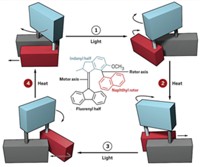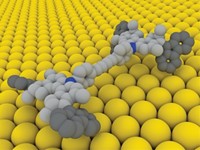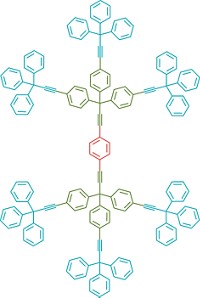Advertisement
Grab your lab coat. Let's get started
Welcome!
Welcome!
Create an account below to get 6 C&EN articles per month, receive newsletters and more - all free.
It seems this is your first time logging in online. Please enter the following information to continue.
As an ACS member you automatically get access to this site. All we need is few more details to create your reading experience.
Not you? Sign in with a different account.
Not you? Sign in with a different account.
ERROR 1
ERROR 1
ERROR 2
ERROR 2
ERROR 2
ERROR 2
ERROR 2
Password and Confirm password must match.
If you have an ACS member number, please enter it here so we can link this account to your membership. (optional)
ERROR 2
ACS values your privacy. By submitting your information, you are gaining access to C&EN and subscribing to our weekly newsletter. We use the information you provide to make your reading experience better, and we will never sell your data to third party members.
Materials
Nanomachinery Gets a Lift
Molecular elevator shifts platform mechanically between two levels
by MICHAEL FREEMANTLE
March 22, 2004
| A version of this story appeared in
Volume 82, Issue 12

A molecular machine consisting of two mechanically interlocked components behaves like a nanometer-scale elevator, according to the chemists in California and Italy who built the machine.
The nano-actuator is made of a platformlike component with a central floor fused to three macrocyclic rings that loop around three legs of a tripodlike component. The team that designed and synthesized the machine included chemistry professor J. Fraser Stoddart, director of the California NanoSystems Institute at the University of California, Los Angeles, and chemistry professor Vincenzo Balzani and assistant professor of chemistry Alberto Credi at the University of Bologna, Italy [Science, 303, 1845 (2004)].
The system is about 2.5 nm in height and 3.5 nm in diameter. Each leg has two recognition sites: an upper dialkylammonium site and a lower bipyridinium site. When base is added to the system, the platform moves down the tripod to the lower level. Addition of acid returns the platform to the upper level. The tripod legs have bulky feet that prevent the platform from slipping off.
"This work beautifully demonstrates the rapid progress that is being made in the construction of artificial molecular motors and machines," comments molecular motor expert Ben L. Feringa, a chemistry professor at the University of Groningen, in the Netherlands.
"The significance of this work is the level of organization reached where several parts of the complex system function properly," he continues. "In this case, three discrete steps allow the well-defined mechanical movement to take place."
The energy needed to raise and lower the platform between the two levels of the tripod is supplied by the acid-base reaction.
"The distance traveled by the platform is about 0.7 nm," the authors note. They estimate on thermodynamic grounds that the elevator could generate a force of up to 200 piconewtons on moving from the upper to the lower level.
They also point out that when the platform is at the lower level, a potentially large cavity opens up. The cavity, which has three amine functions as its sides and aromatic rings as its floor and roof, could host large guest molecules. The hosting capacity of the system might be switched on and off using the acid-base control mechanism.
When the platform is on the upper level, the three bipyridinium units are not engaged in any interactions and the elevator is therefore free to move its legs. Consequently, the units could form adducts with other electron-donor species present in solution, allowing the adduct-forming capacity of the legs to be controlled electrochemically.
"It should also not be difficult to functionalize the three feet of the elevator with thiol groups in order to obtain an ordered array of these machines on a metal surface" such as gold, Balzani says. "Our work is now moving in this direction."





Join the conversation
Contact the reporter
Submit a Letter to the Editor for publication
Engage with us on Twitter